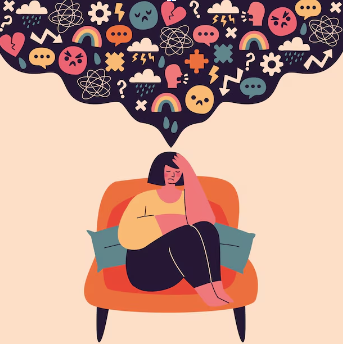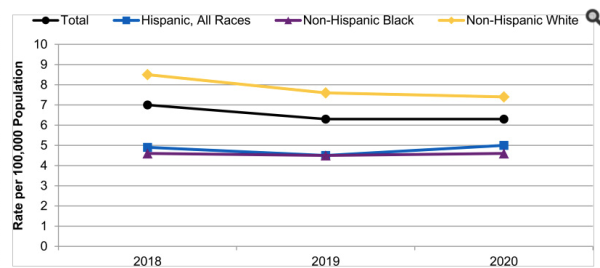
As many of you are probably already aware of, mental well-being, specifically for students, is on a steep decline. Unfortunately, this increasing poor mental health is not being paired with adequate resources and awareness, only contributing to this downward trend. Some groups are at an even greater risk, such as females, those of different racial and ethnic groups, and LGBTQ+ youth. Not only is the rise of poor mental health a national crisis; it is a schoolwide one as well. We decided to collect data from Carver students pertaining to mental health by uploading a voluntary survey on social media. 45 students responded, and here were some of our findings: 
Other Research Findings
- More than 70% of students surveyed reported feeling anxiety frequently, with 20% rating these feelings as “very severe and frequent”.
- Most students reported experiencing physical pain/aches (ex headaches and muscle aches) in their bodies when feeling stressed out.
- 48.9% of high school students rate academic pressure as their #1 contributor to stress, followed by self-pressure, juggling of responsibilities, familial pressure, and peer pressure.
- Almost all students reported feeling burnt out (feelings of exhaustion from prolonged stress) at times, with 15% feeling burnt out every day.
- 75.6% of students agree that their mental health has worsened over time.
- Some of the most common symptoms students may experience when feeling stressed include a racing heart (82.2%), jitters (66.7%), a headache (64.4%), and fatigue (57.8%).
- Some of the most popular coping strategies students utilize to mitigate stress/poor mental health include: listening to music (82.2%), scrolling through social media (82.2 %), watching TV (62.2%), eating (53.3 %), physical activity (51.1%), and use of illicit drugs (15.6%). Unfortunately, healthy coping mechanisms, such as journaling and therapy, are far less common, being substituted by overconsumption of technology and substance abuse.
Although these results are saddening, they are by no means surprising. Despite teen mental health struggles being widely acknowledged, virtually nothing is being done to tackle them. So, what’s the solution? What measures can we, as Carver Center and BCPS students, take to bring about positive change?
Proposed Solutions
Recently, the concept of students taking mental health days (which would consist of allotted days that would be considered excused absences, similar to sick days) has risen in popularity. Not only do these days allow students to get some much-needed relaxation and recharging, but they also serve to destigmatize teen mental health in general, setting the stage for greater change. 13 states have already passed legislation approving mental health days in schools, with several more states proposing bills regarding the matter. In 2021, Bill 461 was proposed in Maryland, which would allow students to take one mental health day per quarter. However, this bill was never passed. Some school systems in Maryland, such as Anne Arundel County Schools, have already adopted such measures. However, BCPS schools have yet to implement mental health days.
Another option that could serve to ameliorate poor mental health is bringing back asynchronous school days. Do you remember asynchronous Wednesdays during virtual learning? Rather than attending classes, teachers posted assignments for students to complete in their own time via Schoology. Not only did asynchronous days provide students with more time to catch up on sleep and complete assignments on their own schedule, but they also gave teachers planning and relaxation time, because hey–teachers need breaks too! Bringing back these days once or twice a month could be beneficial, for both students and teachers.
Teachers Talk
We decided to ask some teachers about their opinions regarding the implementation of mental health days and asynchronous days. First, we spoke to the wonderful Mr. Cox (history/psychology). He believes that mental health days “should be treated like any other illness day, since it’s your health, so it should be treated just as if you have a fever.” When asked about bringing back asynchronous days, Mr. Cox responded enthusiastically: “I think we all, teachers and students across all grade levels, benefitted from asynchronous days. It was just a time to get organized, or a time to recover, getting your mind in a good spot. It also provided a lot of flexibility that I think everyone needs.” He also suggested that if just 10 minutes were added to each school day, we could get an asynchronous day once or twice a month, providing a logistical way to implement such days.
We also talked to the one and only Mrs. Bonincontri, who agreed with our ideas as well. Bringing back asynchronous days is a “fantastic idea”, she stated, as it would allow everyone to “get caught up on things”. She also suggested returning biweekly REPS, since “that half hour for wildcat time isn’t enough.” REPS consisted of designated days in which students could stay after school for assistance with their classes; for example, to ask any questions or make up missing work.
Conclusion
Now you might be wondering, why is addressing teen mental health so important? Isn’t experiencing some stress and depression just a part of life? Yes, ups and downs are part of the natural cycle of life, but when poor mental health escalates to the extreme, something must be changed. With the age of social media, life has gotten much more fast-paced, competitive, and intense. Specifically, students are expected to balance everything while also maintaining a good mental state, which proves to be quite challenging. Currently, schools provide few resources for students to relieve such stress, leading to burnout and subsequent anxiety, depression, and low self-esteem. The situation has gotten so dire that according to a study, 73 percent of high school students are regularly not getting a healthy amount of sleep, which is a minimum of 8 hours (2).
Even though we collected a relatively small sample in our study, which was primarily representative of 11th graders, we think it’s safe to say that teen mental health is going in the wrong direction. This is corroborated by several recent studies. For example, a study conducted by the United States National Library of Medicine found that “nearly 20% of children and young people ages 3-17 in the United States have a mental, emotional, developmental, or behavioral disorder, and suicidal behaviors among high school students increased more than 40% in the decade before 2019” (3).
We believe that implementing specific measures within schools, such as mental health days and asynchronous days, could alleviate student stress. Rest days are crucial to refuel and rejuvenate, both physically and mentally. Implementing designated mental health and asynchronous days only touches the tip of the iceberg; however, large-scale change must start with small steps in the right direction. Hence, we must advocate for such change now.
Sources:
- https://www.verywellmind.com/us-states-allowing-student-mental-health-days-5270047
- https://www.ncbi.nlm.nih.gov/books/NBK587174/


Stone Baland • Nov 20, 2024 at 2:39 pm
Statistics are one thing, feeling constantly awful while needing to pretend to be fine is a pain that can’t be put on a graph